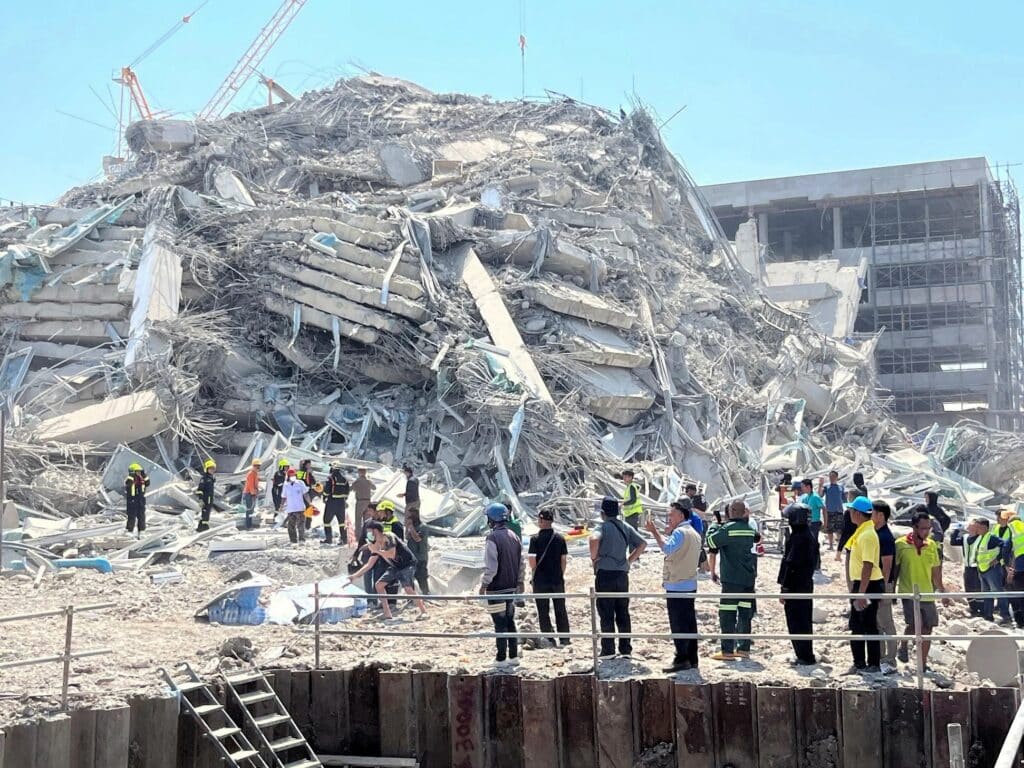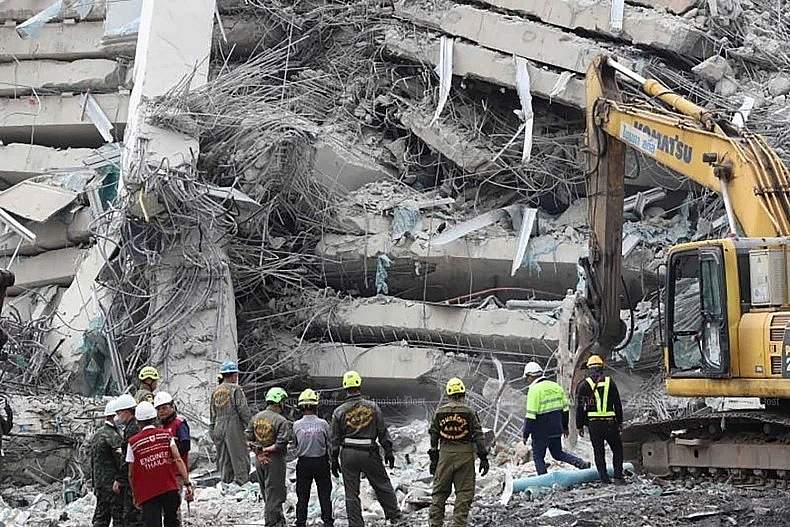Following the devastating 7.7-magnitude earthquake that struck Myanmar on March 28, Thai authorities announced a comprehensive investigation into the cause of the collapse of a 30-story building in the Chatuchak district of Bangkok. This was the only building in the Thai capital to collapse as a result of the earthquake’s aftershocks.
Earthquake Details and Impact
The earthquake struck central Myanmar, near its borders with Thailand and Laos, causing severe tremors felt in several neighboring countries, including Thailand.
Although the epicenter of the earthquake was hundreds of kilometers from Bangkok, its massive force sent shockwaves that reached the Thai capital, raising concerns about potential damage to buildings not equipped to withstand earthquakes.
Preliminary Investigations
The Thai Ministry of Industry has dispatched a specialized team to collect samples of building materials at the site of the collapsed General Auditing Office (SAO) building, which was under construction. Pongpol Yodmuangcharoen, Private Secretary to the Minister of Industry, confirmed that the investigation is focusing on the quality of the reinforcing steel used in the concrete columns, beams, and foundations, as it is suspected that the use of substandard construction materials may have been the cause of the collapse.
For his part, Anutin Charnvirakul, Deputy Prime Minister and Minister of the Interior, stated that the investigation will first examine the building’s design’s compliance with earthquake-resistant standards, as required by law.
He added that if the design is found to be sound, the investigation will move to further stages, including the quality of implementation and construction supervision.
Legal Accountability
Anutin indicated that the project’s contractors, the Thai Italian-Thai Development Company in partnership with a Chinese subsidiary of China Railway Energy Group, will bear full responsibility for the collapse and its consequences.
He emphasized that the government will take strict action against any shortcomings in specifications or implementation.
Lessons Learned
This incident highlights the importance of adhering to earthquake-resistant building standards, especially in earthquake-prone areas. It also highlights the need to strengthen oversight of major construction projects to ensure the safety of citizens.
Finally, as Thai authorities continue their investigations, the biggest question remains: Was the collapse the result of human error or an irresistible natural force? The answer will be determined by the results of the investigation, which is expected to lead to improved building standards in Thailand to prevent similar disasters in the future.
Myanmar Earthquake
A powerful earthquake measuring 7.7 on the Richter scale struck central Myanmar on March 28, causing widespread destruction and significant human and material losses.
The earthquake occurred at a depth of 10 kilometers, which increased its devastating impact as aftershocks spread to neighboring countries such as Thailand, Laos, Bangladesh, and India, and were felt by millions of people.
Casualties and Losses
The earthquake killed more than 150 people, injured hundreds more, and displaced thousands of people who lost their homes. Rural areas in Myanmar were particularly hard hit, with houses built of brick and wood, ill-equipped to withstand tremors of this magnitude, collapsing.
Due to the poor infrastructure in some remote areas, rescue efforts were delayed, increasing the death toll.

Physical and Infrastructure Destruction
Many government buildings, schools, and roads were severely damaged, especially in cities such as Mandalay and Bagan, where centuries-old archaeological sites were damaged.
The earthquake also triggered landslides in mountainous areas, isolating entire villages and hindering the delivery of humanitarian aid.
Economic and Social Implications
Myanmar is a poor country with weak infrastructure, making the earthquake’s impact even more severe.
The government declared a state of emergency in the affected areas, while international organizations such as the Red Cross and the United Nations began providing urgent aid to survivors.
This earthquake is one of the strongest to hit the region in recent years, reminiscent of the 2015 Nepal earthquake, which left thousands dead.
Now, Myanmar faces significant challenges in reconstruction and assisting survivors, while lessons learned are prompting neighboring countries, such as Thailand, to review building regulations to avoid similar disasters in the future.

A 30-story building collapsed in Bangkok following a 7.7-magnitude earthquake that struck Myanmar on March 28. It was the only building to collapse in the Thai capital due to the tremors. Authorities are investigating the quality of construction materials and the building’s design, with a focus on the reinforcing steel and foundations. Contractors will be held accountable if negligence is proven. The incident highlights the importance of adhering to earthquake-resistant building standards.




